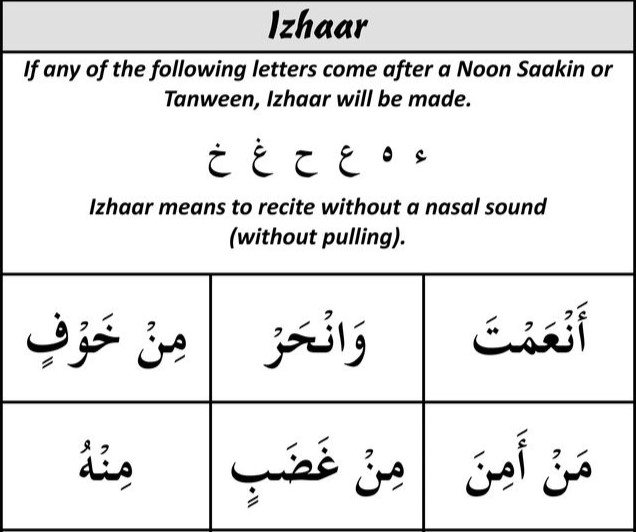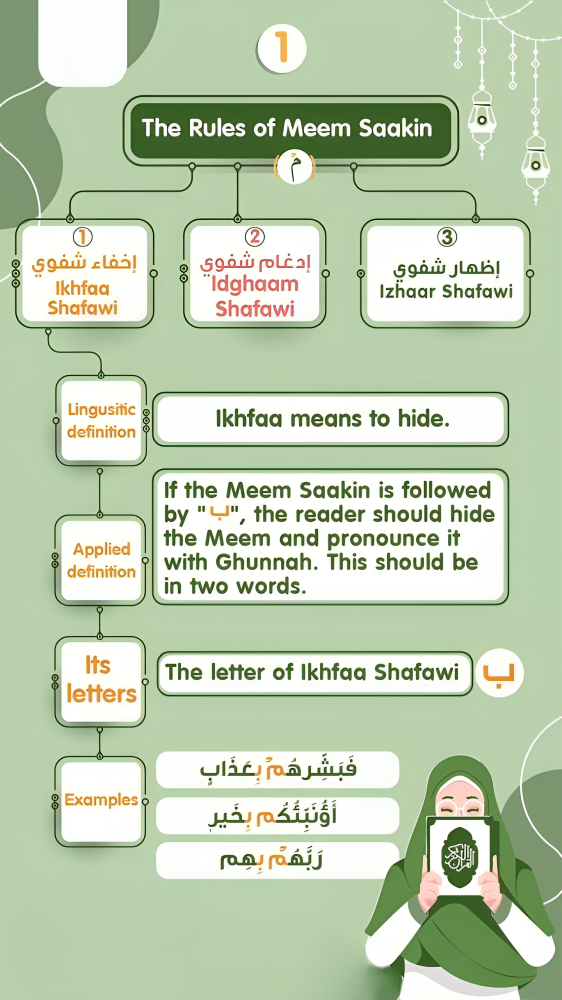Tajweed, the art of correctly pronouncing the Qur’an, holds immense significance for Muslims worldwide. Among its many rules, Izhar is a foundational concept. Understanding Izhar ensures clarity and accuracy in reciting the words of Allah. This blog delves into Izhar, its rules, examples, and how you can perfect it to elevate your Qur’anic recitation.
What is Izhar in Tajweed?
The term Izhar (إظهار) in Arabic means “clarity” or “to make clear.” In Tajweed, Izhar refers to the clear pronunciation of a noon sakinah (نْ) or tanween (ـً, ـٍ, ـٌ) without merging it with the subsequent letter. The sound is pronounced distinctly from the throat, ensuring it remains pure and unaffected by nasalization (ghunnah).
The Letters of Izhar
Izhar applies when noon sakinah or tanween is followed by one of the six letters of the throat, known as the Halaqiyyah letters:
- ء (Hamzah)
- هـ (Haa’)
- ع (Ain)
- ح (Haa)
- غ (Ghayn)
- خ (Khaa)
These letters originate from the throat, making their articulation distinct.
Rules of Izhar
- When It Occurs
- Izhar applies to noon sakinah or tanween when any of the six throat letters immediately follow.
- It can occur within a single word, between two words, or even across sentences.
- How to Pronounce It
- The noon or tanween sound is articulated clearly without elongation or nasalization.
- The throat letter is pronounced distinctly after the noon or tanween sound.
Examples of Izhar in the Qur’an
- Noon Sakinah with Izhar
Surah Al-Fil (105:3)- Example:”فَجَعَلَهُمْ كَعَصْفٍ مَأْكُولٍ”
- Explanation: The noon sakinah in “كَعَصْفٍ” is followed by the throat letter Hamzah (مَأْكُولٍ), requiring Izhar.
- Example:”فَجَعَلَهُمْ كَعَصْفٍ مَأْكُولٍ”
- Tanween with Izhar
Surah Al-Baqarah (2:2)- Example:”هُدًى لِلْمُتَّقِينَ”
- Explanation: The tanween in “هُدًى” is followed by the throat letter Hamzah (لِلْمُتَّقِينَ), requiring Izhar.
- Example:”هُدًى لِلْمُتَّقِينَ”
Common Mistakes in Izhar
- Excessive Stress
- Overemphasizing the throat letters can distort the recitation.
- Nasalization
- Adding a nasal sound (ghunnah) where it is not required compromises the rule of Izhar.
- Skipping the Izhar Rule
- Merging the noon or tanween with the following throat letter leads to incorrect recitation.
Tips to Perfect Izhar
- Understand the Articulation Points
- Learn the Makharij (articulation points) of the six throat letters to ensure clarity.
- Practice Regularly
- Repeat words and verses containing Izhar under the guidance of a qualified teacher.
- Use Audio Resources
- Listen to recordings of expert Qaris (reciters) to grasp the proper application of Izhar.
- Seek Feedback
- Recite to a teacher or experienced Tajweed practitioner to identify and correct errors.
Importance of Izhar in Tajweed
Mastering Izhar is not just about technical precision; it reflects your dedication to preserving the sanctity of Allah’s words. Correct Tajweed beautifies the recitation, facilitates understanding, and ensures that the Qur’an is recited as it was revealed to Prophet Muhammad (ﷺ).
Conclusion
Izhar is an essential Tajweed rule that emphasizes the clarity and purity of Qur’anic recitation. By understanding and practicing Izhar, you contribute to the preservation of the Qur’an’s linguistic and spiritual integrity. At Baytul Quran, we offer comprehensive Tajweed courses to help you master Izhar and other rules of Tajweed with ease and confidence.
Start Your Tajweed Journey Today!
Explore our Tajweed courses at Baytul Quran and take the first step toward perfecting your Qur’anic recitation.





